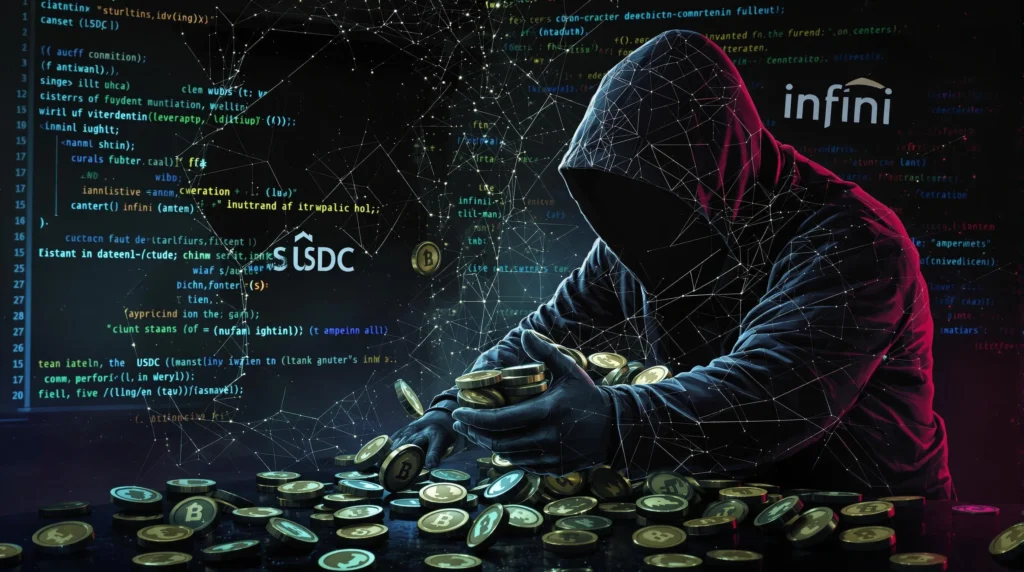Shocking $50M Crypto Exploit: Infini Suspects Developer Deception in Massive USDC Theft

In a stunning turn of events shaking the cryptocurrency world, Infini, a prominent crypto payments firm, has fallen victim to a massive exploit resulting in the theft of $50 million in USDC. Initial investigations point towards a deeply concerning source: a rogue developer suspected of leveraging retained admin rights for personal gain. This incident raises serious questions about security protocols and the trust placed in developers within the decentralized finance (DeFi) space. Let’s dive into the details of this alarming crypto exploit and what it means for the future of digital asset security.
What Happened in the Infini Crypto Exploit?
The timeline of the crypto exploit is still being pieced together, but here’s what we know so far:
- Infini, a crypto payments firm, detected unusual activity indicating a significant outflow of USDC from their wallets.
- Upon investigation, it was discovered that approximately $50 million in USDC had been illicitly transferred out.
- Suspicion quickly fell upon a developer who had previously worked on the Infini project and crucially, retained administrative privileges even after project completion.
- Evidence suggests that these admin rights were abused to orchestrate the crypto theft.
- The identity of the developer and the exact method of the exploit are still under investigation, but the focus remains on unauthorized access facilitated by retained admin controls.
This incident underscores a critical vulnerability in project management and security within the crypto sphere. The assumption of trust, even after project handover, can have devastating consequences when malicious actors are involved.
Developer Deception: Was It an Inside Job?
The term developer deception is being heavily circulated in crypto circles following this incident, and for good reason. The evidence strongly suggests that this was not an external hack, but rather an inside job executed by someone with intimate knowledge of Infini’s systems and privileged access.
Why is developer deception such a concerning aspect of this exploit?
- Breach of Trust: Projects rely heavily on the integrity and trustworthiness of their development teams. This incident shatters that trust and creates a climate of suspicion.
- Internal Vulnerability: Traditional security measures often focus on external threats. Developer deception highlights the critical need for robust internal security protocols and oversight, especially concerning privileged access.
- Difficulty in Detection: Insider threats are notoriously difficult to detect as malicious actions can be disguised as legitimate administrative tasks.
- Reputational Damage: For Infini, the reputational damage stemming from this incident is significant. Users and investors may lose confidence in their security measures.
The $50 Million Crypto Theft: A Breakdown of the Losses
The sheer scale of this $50 million crypto theft is alarming. To put it into perspective, this is not just a minor security breach; it represents a substantial financial blow to Infini and potentially its users.
Let’s break down what the loss of $50 million USDC means in the context of crypto exploits:
| Aspect | Impact of $50 Million Loss |
|---|---|
| Financial Stability | A $50 million loss can severely impact Infini’s financial stability, potentially hindering its operational capabilities and future development plans. |
| User Confidence | Such a significant theft erodes user confidence in the platform. Users may become hesitant to use Infini’s services, fearing further security vulnerabilities. |
| Market Perception | The exploit negatively impacts market perception of Infini and potentially the wider crypto payments sector. It can lead to decreased investment and slower adoption rates. |
| Regulatory Scrutiny | Major exploits often attract regulatory attention, leading to increased scrutiny and potentially stricter compliance requirements for crypto firms. |
| Recovery Efforts | Recovering $50 million in stolen crypto is a daunting task, often with low success rates. Infini will need to dedicate significant resources to investigation and recovery efforts. |
USDC Under Scrutiny: Is Stablecoin Security at Risk?
The fact that the stolen funds were in USDC, a leading stablecoin pegged to the US dollar, raises broader questions about stablecoin security. While stablecoins are designed to offer stability in the volatile crypto market, they are not immune to exploits and thefts. This USDC theft highlights the ongoing need for enhanced security measures across all crypto assets, including stablecoins.
Key takeaways regarding stablecoin security in light of this exploit:
- Stablecoins are Targets: Their peg to fiat currencies and perceived stability make them attractive targets for exploits as they represent readily convertible value.
- Security is Paramount: The Infini exploit reinforces that security cannot be compromised, even for assets considered “stable.” Robust security protocols are essential for all crypto holdings.
- Transparency and Audits: Regular security audits and transparent practices are crucial for building trust in stablecoin platforms and demonstrating their commitment to security.
- User Education: Users also play a role in security. Understanding the risks associated with different platforms and practicing good security hygiene is vital.
Moving Forward: Lessons Learned from the Infini Exploit
The Infini crypto exploit serves as a harsh but necessary lesson for the entire cryptocurrency industry. It underscores the ever-present threat of both external and internal vulnerabilities and the critical importance of proactive security measures.
Actionable insights and steps to mitigate future risks:
- Enhanced Access Control: Implement stricter access control policies, especially for administrative privileges. Adopt the principle of least privilege, granting only necessary access and regularly reviewing permissions.
- Rigorous Audits: Conduct regular and comprehensive security audits, both internal and external, to identify and address potential vulnerabilities.
- Multi-Signature Wallets: Employ multi-signature wallets for holding significant funds, requiring multiple approvals for transactions, thus reducing the risk of single-point-of-failure exploits.
- Developer Vetting and Monitoring: Implement thorough vetting processes for developers and continuous monitoring of their activities, especially those with privileged access.
- Incident Response Plan: Develop and regularly test a comprehensive incident response plan to effectively handle security breaches and minimize damage.
- Transparency and Communication: Maintain transparency with users regarding security incidents and communicate openly about steps taken to address vulnerabilities and prevent future occurrences.
Conclusion: A Wake-Up Call for Crypto Security
The Infini exploit is a stark reminder that even in the rapidly evolving world of cryptocurrency, fundamental security principles remain paramount. The alleged developer deception and subsequent crypto theft highlight the need for a multi-layered approach to security that encompasses not only technological safeguards but also robust internal controls and a culture of security awareness. As the crypto industry matures, learning from incidents like this is crucial to building a more secure and trustworthy ecosystem for all participants. The future of DeFi hinges on its ability to address these vulnerabilities and demonstrate a unwavering commitment to protecting user funds and maintaining the integrity of the system.







